Cleotilde Gonzalez
Measuring Implicit Spatial Coordination in Teams: Effects on Collective Intelligence and Performance
Sep 11, 2025Abstract:Coordinated teamwork is essential in fast-paced decision-making environments that require dynamic adaptation, often without an opportunity for explicit communication. Although implicit coordination has been extensively considered in the existing literature, the majority of work has focused on co-located, synchronous teamwork (such as sports teams) or, in distributed teams, primarily on coordination of knowledge work. However, many teams (firefighters, military, law enforcement, emergency response) must coordinate their movements in physical space without the benefit of visual cues or extensive explicit communication. This paper investigates how three dimensions of spatial coordination, namely exploration diversity, movement specialization, and adaptive spatial proximity, influence team performance in a collaborative online search and rescue task where explicit communication is restricted and team members rely on movement patterns to infer others' intentions and coordinate actions. Our metrics capture the relational aspects of teamwork by measuring spatial proximity, distribution patterns, and alignment of movements within shared environments. We analyze data from 34 four-person teams (136 participants) assigned to specialized roles in a search and rescue task. Results show that spatial specialization positively predicts performance, while adaptive spatial proximity exhibits a marginal inverted U-shaped relationship, suggesting moderate levels of adaptation are optimal. Furthermore, the temporal dynamics of these metrics differentiate high- from low-performing teams over time. These findings provide insights into implicit spatial coordination in role-based teamwork and highlight the importance of balanced adaptive strategies, with implications for training and AI-assisted team support systems.
Controllable Complementarity: Subjective Preferences in Human-AI Collaboration
Mar 07, 2025Abstract:Research on human-AI collaboration often prioritizes objective performance. However, understanding human subjective preferences is essential to improving human-AI complementarity and human experiences. We investigate human preferences for controllability in a shared workspace task with AI partners using Behavior Shaping (BS), a reinforcement learning algorithm that allows humans explicit control over AI behavior. In one experiment, we validate the robustness of BS in producing effective AI policies relative to self-play policies, when controls are hidden. In another experiment, we enable human control, showing that participants perceive AI partners as more effective and enjoyable when they can directly dictate AI behavior. Our findings highlight the need to design AI that prioritizes both task performance and subjective human preferences. By aligning AI behavior with human preferences, we demonstrate how human-AI complementarity can extend beyond objective outcomes to include subjective preferences.
Modeling Attention during Dimensional Shifts with Counterfactual and Delayed Feedback
Jan 19, 2025

Abstract:Attention can be used to inform choice selection in contextual bandit tasks even when context features have not been previously experienced. One example of this is in dimensional shifts, where additional feature values are introduced and the relationship between features and outcomes can either be static or variable. Attentional mechanisms have been extensively studied in contextual bandit tasks where the feedback of choices is provided immediately, but less research has been done on tasks where feedback is delayed or in counterfactual feedback cases. Some methods have successfully modeled human attention with immediate feedback based on reward prediction errors (RPEs), though recent research raises questions of the applicability of RPEs onto more general attentional mechanisms. Alternative models suggest that information theoretic metrics can be used to model human attention, with broader applications to novel stimuli. In this paper, we compare two different methods for modeling how humans attend to specific features of decision making tasks, one that is based on calculating an information theoretic metric using a memory of past experiences, and another that is based on iteratively updating attention from reward prediction errors. We compare these models using simulations in a contextual bandit task with both intradimensional and extradimensional domain shifts, as well as immediate, delayed, and counterfactual feedback. We find that calculating an information theoretic metric over a history of experiences is best able to account for human-like behavior in tasks that shift dimensions and alter feedback presentation. These results indicate that information theoretic metrics of attentional mechanisms may be better suited than RPEs to predict human attention in decision making, though further studies of human behavior are necessary to support these results.
Improving the Prediction of Individual Engagement in Recommendations Using Cognitive Models
Sep 03, 2024



Abstract:For public health programs with limited resources, the ability to predict how behaviors change over time and in response to interventions is crucial for deciding when and to whom interventions should be allocated. Using data from a real-world maternal health program, we demonstrate how a cognitive model based on Instance-Based Learning (IBL) Theory can augment existing purely computational approaches. Our findings show that, compared to general time-series forecasters (e.g., LSTMs), IBL models, which reflect human decision-making processes, better predict the dynamics of individuals' states. Additionally, IBL provides estimates of the volatility in individuals' states and their sensitivity to interventions, which can improve the efficiency of training of other time series models.
Leveraging a Cognitive Model to Measure Subjective Similarity of Human and GPT-4 Written Content
Aug 30, 2024



Abstract:Cosine similarity between two documents can be computed using token embeddings formed by Large Language Models (LLMs) such as GPT-4, and used to categorize those documents across a range of uses. However, these similarities are ultimately dependent on the corpora used to train these LLMs, and may not reflect subjective similarity of individuals or how their biases and constraints impact similarity metrics. This lack of cognitively-aware personalization of similarity metrics can be particularly problematic in educational and recommendation settings where there is a limited number of individual judgements of category or preference, and biases can be particularly relevant. To address this, we rely on an integration of an Instance-Based Learning (IBL) cognitive model with LLM embeddings to develop the Instance-Based Individualized Similarity (IBIS) metric. This similarity metric is beneficial in that it takes into account individual biases and constraints in a manner that is grounded in the cognitive mechanisms of decision making. To evaluate the IBIS metric, we also introduce a dataset of human categorizations of emails as being either dangerous (phishing) or safe (ham). This dataset is used to demonstrate the benefits of leveraging a cognitive model to measure the subjective similarity of human participants in an educational setting.
Towards Neural Network based Cognitive Models of Dynamic Decision-Making by Humans
Jul 24, 2024



Abstract:Modelling human cognitive processes in dynamic decision-making tasks has been an endeavor in AI for a long time. Some initial works have attempted to utilize neural networks (and large language models) but often assume one common model for all humans and aim to emulate human behavior in aggregate. However, behavior of each human is distinct, heterogeneous and relies on specific past experiences in specific tasks. To that end, we build on a well known model of cognition, namely Instance Based Learning (IBL), that posits that decisions are made based on similar situations encountered in the past. We propose two new attention based neural network models to model human decision-making in dynamic settings. We experiment with two distinct datasets gathered from human subject experiment data, one focusing on detection of phishing email by humans and another where humans act as attackers in a cybersecurity setting and decide on an attack option. We conduct extensive experiments with our two neural network models, IBL, and GPT3.5, and demonstrate that one of our neural network models achieves the best performance in representing human decision-making. We find an interesting trend that all models predict a human's decision better if that human is better at the task. We also explore explanation of human decisions based on what our model considers important in prediction. Overall, our work yields promising results for further use of neural networks in cognitive modelling of human decision making. Our code is available at https://github.com/shshnkreddy/NCM-HDM.
Learning in Cooperative Multiagent Systems Using Cognitive and Machine Models
Aug 18, 2023



Abstract:Developing effective Multi-Agent Systems (MAS) is critical for many applications requiring collaboration and coordination with humans. Despite the rapid advance of Multi-Agent Deep Reinforcement Learning (MADRL) in cooperative MAS, one major challenge is the simultaneous learning and interaction of independent agents in dynamic environments in the presence of stochastic rewards. State-of-the-art MADRL models struggle to perform well in Coordinated Multi-agent Object Transportation Problems (CMOTPs), wherein agents must coordinate with each other and learn from stochastic rewards. In contrast, humans often learn rapidly to adapt to nonstationary environments that require coordination among people. In this paper, motivated by the demonstrated ability of cognitive models based on Instance-Based Learning Theory (IBLT) to capture human decisions in many dynamic decision making tasks, we propose three variants of Multi-Agent IBL models (MAIBL). The idea of these MAIBL algorithms is to combine the cognitive mechanisms of IBLT and the techniques of MADRL models to deal with coordination MAS in stochastic environments from the perspective of independent learners. We demonstrate that the MAIBL models exhibit faster learning and achieve better coordination in a dynamic CMOTP task with various settings of stochastic rewards compared to current MADRL models. We discuss the benefits of integrating cognitive insights into MADRL models.
Credit Assignment: Challenges and Opportunities in Developing Human-like AI Agents
Jul 16, 2023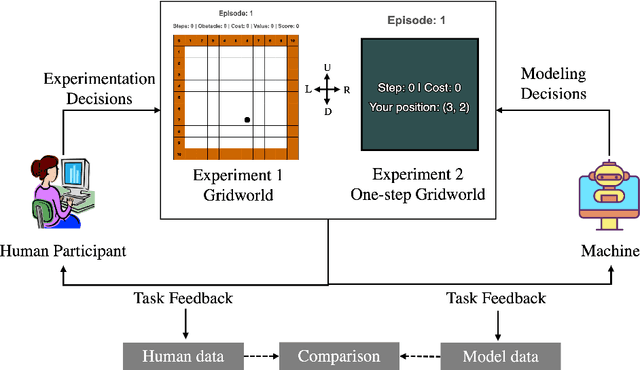
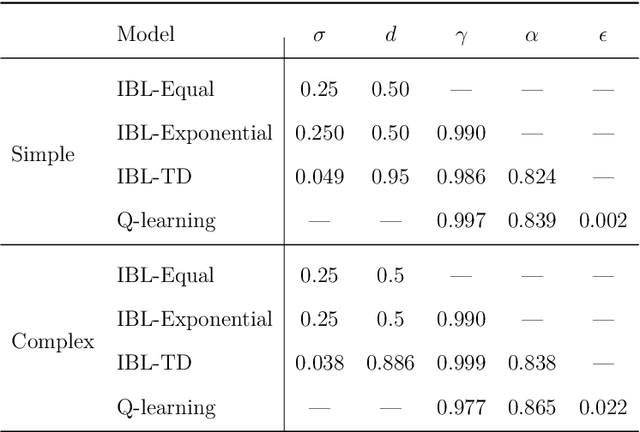
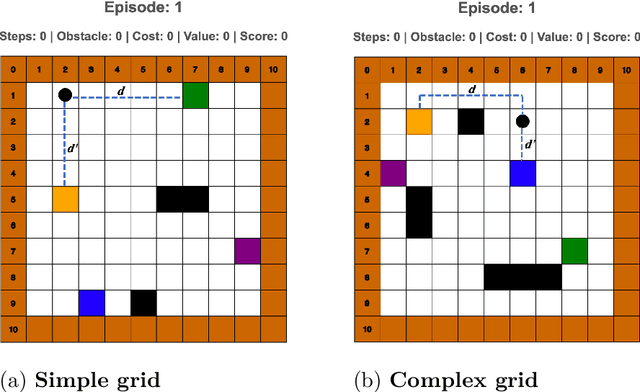
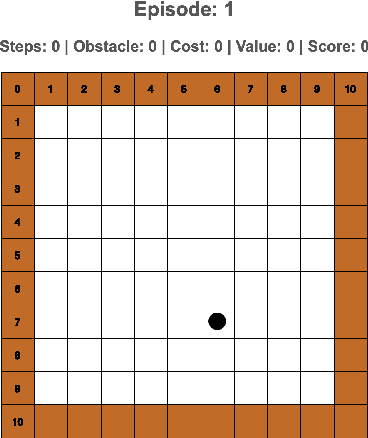
Abstract:Temporal credit assignment is crucial for learning and skill development in natural and artificial intelligence. While computational methods like the TD approach in reinforcement learning have been proposed, it's unclear if they accurately represent how humans handle feedback delays. Cognitive models intend to represent the mental steps by which humans solve problems and perform a number of tasks, but limited research in cognitive science has addressed the credit assignment problem in humans and cognitive models. Our research uses a cognitive model based on a theory of decisions from experience, Instance-Based Learning Theory (IBLT), to test different credit assignment mechanisms in a goal-seeking navigation task with varying levels of decision complexity. Instance-Based Learning (IBL) models simulate the process of making sequential choices with different credit assignment mechanisms, including a new IBL-TD model that combines the IBL decision mechanism with the TD approach. We found that (1) An IBL model that gives equal credit assignment to all decisions is able to match human performance better than other models, including IBL-TD and Q-learning; (2) IBL-TD and Q-learning models underperform compared to humans initially, but eventually, they outperform humans; (3) humans are influenced by decision complexity, while models are not. Our study provides insights into the challenges of capturing human behavior and the potential opportunities to use these models in future AI systems to support human activities.
Learning to Defend by Attacking : Transfer of Learning in Cybersecurity Games
Jun 03, 2023Abstract:Designing cyber defense systems to account for cognitive biases in human decision making has demonstrated significant success in improving performance against human attackers. However, much of the attention in this area has focused on relatively simple accounts of biases in human attackers, and little is known about adversarial behavior or how defenses could be improved by disrupting attacker's behavior. In this work, we present a novel model of human decision-making inspired by the cognitive faculties of Instance-Based Learning Theory, Theory of Mind, and Transfer of Learning. This model functions by learning from both roles in a security scenario: defender and attacker, and by making predictions of the opponent's beliefs, intentions, and actions. The proposed model can better defend against attacks from a wide range of opponents compared to alternatives that attempt to perform optimally without accounting for human biases. Additionally, the proposed model performs better against a range of human-like behavior by explicitly modeling human transfer of learning, which has not yet been applied to cyber defense scenarios. Results from simulation experiments demonstrate the potential usefulness of cognitively inspired models of agents trained in attack and defense roles and how these insights could potentially be used in real-world cybersecurity.
SpeedyIBL: A Solution to the Curse of Exponential Growth in Instance-Based Learning Models of Decisions from Experience
Nov 19, 2021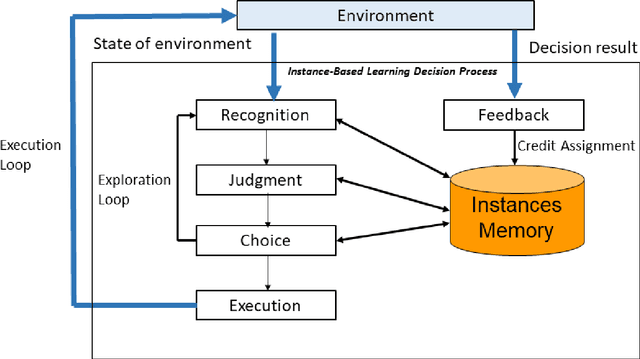


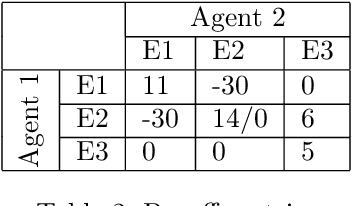
Abstract:Computational cognitive modeling is a useful methodology to explore and validate theories of human cognitive processes. Often cognitive models are used to simulate the process by which humans perform a task or solve a problem and to make predictions about human behavior. Cognitive models based on Instance-Based Learning (IBL) Theory rely on a formal computational algorithm for dynamic decision making and on a memory mechanism from a well-known cognitive architecture, ACT-R. To advance the computational theory of human decision making and to demonstrate the usefulness of cognitive models in diverse domains, we must address a practical computational problem, the curse of exponential growth, that emerges from memory-based tabular computations. When more observations accumulate, there is an exponential growth of the memory of instances that leads directly to an exponential slow down of the computational time. In this paper, we propose a new Speedy IBL implementation that innovates the mathematics of vectorization and parallel computation over the traditional loop-based approach. Through the implementation of IBL models in many decision games of increasing complexity, we demonstrate the applicability of the regular IBL models and the advantages of their Speedy implementation. Decision games vary in their complexity of decision features and in the number of agents involved in the decision process. The results clearly illustrate that Speedy IBL addresses the curse of exponential growth of memory, reducing the computational time significantly, while maintaining the same level of performance than the traditional implementation of IBL models.
 Add to Chrome
Add to Chrome Add to Firefox
Add to Firefox Add to Edge
Add to Edge